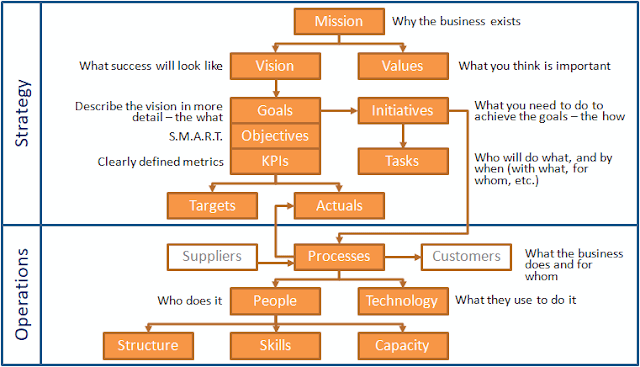What are the key elements of a business strategy and how do they relate to each other?
The above chart maps these out. It includes the key elements of operations which strategy must direct.
The components of the strategy are:
- Mission: defines why the organisation exists; its purpose.
- Vision: defines what the world will look like when the organisation succeeds in its mission. See also: Strategic Vision: 3 tests
- Values: are what the organisation holds dear. They are important in choosing what the organisation will and won't do, and how it will or won't do it, to achieve its mission.
Purists will argue that the Mission, Vision and Values are not part of the strategy itself, but set the context for the strategy. That's true. But most organisations consider them part of their strategy anyway.
- Goals: describe in more detail what the business must achieve to achieve its vision. Goals are often described as defining the financial, customer, operational and learning and innovation perspectives of the vision. See also: Strategic goals versus operational objectives.
- Objectives: break the goals down into specific, measurable, achievable, relevant and time-bound (SMART) achievements.
- KPIs: define the specific measurements which will measure the achievement of the objectives. See also: Six tips on how to pick the best KPIs for your strategy and Getting the most out of KPIs.
- Targets: define what must be achieved. They are expressed in terms of a KPI, within a defined time period.
- Actuals: define what is actually achieved with a period for a measure. If this is inconsistent with a target, then review and remediation may be required.
- Initiatives: define specific changes to be made to the business. They should have a clearly defined end state. They are the actions to be taken to achieve the goals. See also 6 techniques and 5 tips for developing strategic options and How to tune and prune your portfolio of strategic initiatives.
- Tasks or Actions: are the specific steps that need to be taken to achieve the end state defined for an initiative. They define exactly who needs to do what and by when. They may also define what they need in order to do it, and who they are doing it for.
- Processes: what the business does on an ongoing basis. Processes transform the input it receives from its suppliers into the output required by its customers.
- People: who perform the processes.
- Structure: how the people are organised to do so.
- Skills: knowledge, experience and capabilities that the people require to do so.
- Capacity: the number of people required to do it.
- Technology: the systems and equipment required to perform the processes.
For more insight into strategic operations, see How to design a Target Operating Model (TOM).
All of these components, and the relationships between them, can be defined in StratNavApp.com, the online collaborative platform for business strategy development and execution.
Other components included in StratNavApp.com which support the strategy whilst not being part of it include Strategic Insights, Stakeholders, Risks, Issues and Decisions.


No comments:
Post a Comment